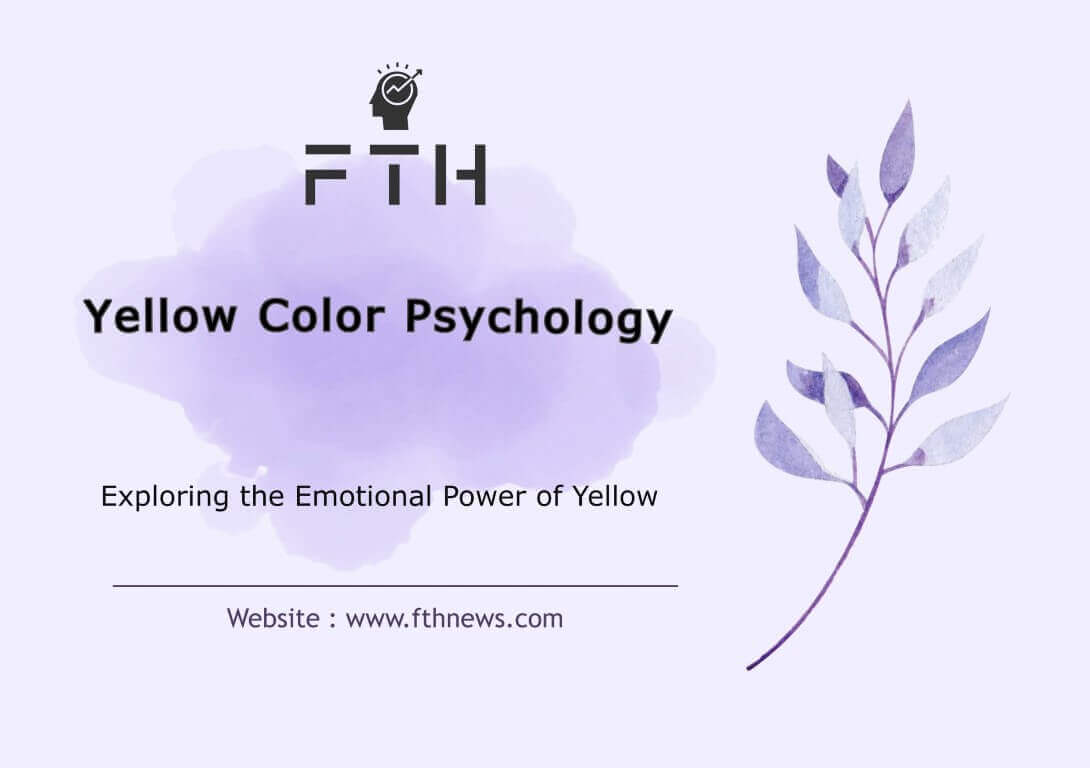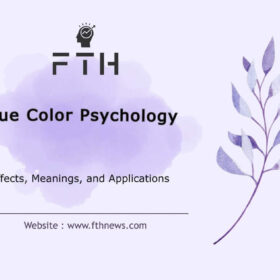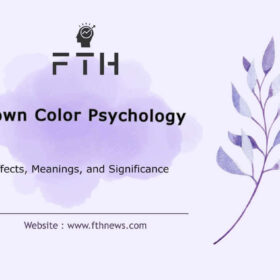
Yellow Color Psychology: Yellow, the color of sunshine, evokes feelings of warmth, happiness, and positivity. But beyond its cheerful appearance, the psychology of yellow is complex and powerful. This vibrant hue can influence emotions, cognitive processes, and even behavior in profound ways. Understanding yellow’s psychological impact can help you harness its power in various aspects of life, from interior design to marketing strategies.
The Emotional Impact of Yellow Color
Yellow is one of the primary warm colors in the color wheel, situated between orange and green. This vibrant hue inspires optimism, energy, and happiness. According to psychologists, if you give a box of crayons to children, they are likely to choose the yellow crayon first! This preference underscores yellow’s innate appeal and its ability to uplift spirits.
Expert Insights Yellow Color Psychology:
Latrice Eisman, an international expert colorist, asserts in her book “Color: Message and Meaning” that yellow is one of the strongest colors psychologically. In the 19th century, yellow ribbons were used to represent hope and optimism, a testament to its positive symbolism. Eisman notes that yellow is associated with the acceptance of new experiences, intimacy, extroversion, and happiness. This color fosters playfulness, joy, and a sense of comedy in people, making it a powerful tool for emotional enhancement.
Angela Wright, another global expert on the unconscious effects of color, emphasizes in her book “A Beginner’s Guide to Color Psychology” that yellow is closely linked to self-esteem, emotions, and creativity. According to Wright, yellow evokes feelings of hope, laughter, warmth, and energy. Introducing yellow into dull or dark environments can significantly boost happiness and optimism, transforming the overall atmosphere.
The Dual Nature of Yellow
While yellow is predominantly associated with positive emotions, it also has a dual nature that can evoke negative reactions if overused. The brightness and intensity of yellow can quickly attract attention, which is why it is often used in cautionary signs and advertisements. However, excessive exposure to yellow can lead to feelings of agitation, irritability, or even anger. This dual impact underscores the need for thoughtful application of yellow in various contexts.
Yellow Psychological Effects
Yellow Color Psychology: Yellow’s psychological effects are wide-ranging and can influence both mood and behavior:
- Optimism and Energy: Yellow’s bright and vibrant nature can lift spirits and boost energy levels, making it ideal for spaces where creativity and activity are desired, such as offices and classrooms.
- Warmth and Happiness: Yellow evokes warmth and happiness, making it a popular choice for social spaces like living rooms and dining areas.
- Attention and Caution: Due to its high visibility, yellow is used in warning signs and advertisements to capture immediate attention and convey caution.
- Creativity and Innovation: Yellow stimulates mental activity and can inspire new ideas and innovative thinking, making it a valuable color in brainstorming sessions and creative projects.
By understanding and leveraging the emotional impact of yellow, individuals and businesses can create environments and experiences that foster positivity, creativity, and engagement. Whether in design, marketing, or everyday life, yellow’s powerful psychological effects can be harnessed to enhance well-being and productivity.
Yellow Color Psychology in Marketing
Marketers and brand strategists have long recognized the power of yellow in capturing attention and conveying messages. Yellow is one of the most visible colors in the spectrum, making it ideal for traffic signs and advertisements. It grabs attention and is often associated with caution and alertness.
The Power of Yellow in Branding
Brands like McDonald’s and IKEA use yellow to evoke a sense of happiness and friendliness. Yellow’s cheerful and approachable nature makes it a great choice for brands aiming to create a positive and inviting image. When combined with the right complementary colors, yellow can create a warm and welcoming brand identity. For instance, the combination of yellow and red is known to stimulate appetite, making it a popular choice in the food industry. McDonald’s, for example, uses this color scheme to attract customers and create a sense of urgency and excitement around their products.
Yellow Color Psychology in Business
Yellow stimulates mental activities and cognitive processes, making it a valuable color in business contexts. Research suggests that people are more likely to remember information written on a yellow background compared to a white one. This makes yellow an effective color for highlighting important information and creating memorable marketing materials.
However, yellow’s high visibility can be a double-edged sword in the workplace. While it can enhance focus and creativity, excessive use of yellow can be distracting and lead to difficulty in concentration. Lighter shades of yellow can also cause irritation and frustration if overused. Therefore, it’s crucial to balance yellow with other colors to create a positive and productive environment.
Using the right amount of yellow can foster a warm and optimistic atmosphere, helping businesses associate themselves with positive outcomes and customer satisfaction. For instance, using yellow accents in a company’s branding or office decor can create a welcoming and energetic environment without overwhelming employees or clients.
Yellow Color Psychology in Interior Design
In interior design, yellow can transform spaces, making them feel more expansive and inviting. Pale yellows can create a serene and tranquil environment, ideal for bedrooms and living spaces. These softer shades promote relaxation and a sense of calm, making them perfect for areas where unwinding is essential.
Bright, bold yellows, on the other hand, are perfect for areas where you want to stimulate creativity and energy, such as home offices and kitchens. These vibrant hues can boost mood and inspire innovative thinking, making them great for spaces dedicated to productivity and activity.
However, the use of yellow must be balanced. Too much yellow can overwhelm and create a sense of tension. Pairing yellow with neutral tones or cooler colors like blue and green can create a harmonious and pleasant environment. For example, a kitchen with bright yellow accents paired with cool blue cabinetry can feel both invigorating and soothing.
Caution with Yellow
While yellow can be energizing, it also has a harsher side. Excessive exposure to yellow can lead to irritability or even anger. People often report increased irritability when in a room with all yellow walls, regardless of their initial mood. This reaction is due to yellow’s high level of brightness, which can be overstimulating.
To avoid overwhelming the senses, it’s crucial to use yellow thoughtfully. Consider using yellow as an accent color rather than the dominant hue in a room. This approach allows you to reap the benefits of yellow’s positivity and energy without the risk of creating a stressful environment. For instance, incorporating yellow throw pillows, artwork, or decor items can add a touch of brightness and cheerfulness to a space without overpowering it.
In summary, yellow’s psychological impact makes it a powerful tool in marketing, branding, and interior design. By understanding how to use yellow effectively, you can create environments and experiences that promote positivity, creativity, and engagement. Whether you’re designing a brand’s visual identity or decorating a home, yellow’s vibrant and versatile nature can help you achieve your goals.
The Effects of Yellow Color on the Brain
Yellow, as a color, has a profound impact on brain activities and cognitive processes. Its effects can be both positive and negative, depending on the context and the amount of exposure.
Positive Effects of Yellow on the Brain
1. Strong Analytical Thinking: Yellow stimulates the left side of the brain, which is associated with logical thinking and problem-solving. This makes yellow an excellent color for environments where analytical thinking and attention to detail are crucial, such as study rooms and workspaces.
2. Increased Mental Activity: Exposure to yellow can enhance cognitive functions by promoting alertness and mental clarity. This heightened state of awareness can improve focus and efficiency, making it easier to tackle complex tasks and think critically.
3. Enhanced Awareness: Yellow increases overall sensory perception, helping individuals to become more aware of their surroundings. This can be particularly beneficial in settings where attention to detail and situational awareness are important, such as classrooms and workplaces.
4. Boosted Energy Levels: The bright and vibrant nature of yellow can help to invigorate and energize individuals. It is often associated with the warmth and vitality of the sun, which can uplift spirits and promote a sense of well-being. This makes yellow a great choice for spaces where maintaining high energy levels is essential.
5. Accelerated Metabolic Activity: Yellow has been linked to increased metabolic rates, which can enhance physical energy and stamina. This can be particularly beneficial in environments where physical activity and productivity are important, such as gyms and creative studios.
Negative Effects of Yellow on the Brain
1. Increased Irritability: While yellow can boost energy levels, it can also lead to increased irritability if overused. The color’s high intensity can be overstimulating, causing people to feel restless or agitated. This is why it’s important to use yellow in moderation, particularly in environments where calm and concentration are needed.
2. Heightened Anger: Prolonged exposure to intense yellow can evoke feelings of frustration and anger. This reaction is likely due to yellow’s stimulating effect on the nervous system, which can become overwhelming if not balanced with calmer colors.
3. Elevated Fatigue: Ironically, while yellow can boost energy levels, excessive exposure can also lead to fatigue. The brightness of yellow can strain the eyes and lead to visual fatigue, particularly if used in large areas or in high-intensity lighting conditions.
4. Increased Anxiety: Yellow’s stimulating properties can sometimes heighten anxiety levels, especially in individuals who are already prone to stress. The color’s intense vibrancy can be overwhelming and contribute to feelings of unease or nervousness.
5. Eye Strain: Due to its high luminance, yellow can cause significant eye strain if used excessively. This is especially true for bright, saturated shades of yellow. To avoid discomfort, it’s important to balance yellow with softer, more neutral tones and ensure adequate breaks from its visual intensity.
Balancing Yellow in Different Environments
To harness the positive effects of yellow while mitigating its potential downsides, consider the following tips:
- Use Yellow as an Accent Color: Instead of using yellow as the dominant color in a room, incorporate it as an accent through decor items, artwork, or furniture. This approach allows you to enjoy the benefits of yellow without overwhelming the space.
- Pair Yellow with Neutral Tones: Combining yellow with neutral colors like white, gray, or beige can help balance its intensity and create a more harmonious environment.
- Consider Lighting Conditions: Be mindful of the lighting in spaces where yellow is used. Natural light can enhance the warmth and positivity of yellow, while artificial lighting should be adjusted to avoid creating overly bright and stimulating conditions.
- Personalize Based on Usage: Tailor the use of yellow to the specific needs of each space. For example, use softer, paler shades of yellow in bedrooms to promote relaxation, while reserving brighter, more vibrant yellows for creative and active areas.
By thoughtfully integrating yellow into various environments, you can maximize its positive effects on the brain while minimizing any potential negative impacts.
What Personality is Yellow Associated With?
Yellow, a vibrant and lively color, is often associated with a range of personality traits. People who favor yellow tend to embody the energy and positivity that the color represents. Here are some key characteristics commonly linked to the color yellow:
Positive Traits
1. Optimistic and Cheerful: Individuals who are drawn to yellow are typically optimistic and have a sunny disposition. They see the bright side of situations and are often able to uplift those around them with their positive outlook on life.
2. Creative and Imaginative: Yellow is linked to creativity and innovation. People who favor yellow often have a vivid imagination and are skilled at generating new ideas and solutions. They thrive in environments that allow for creative expression and are often involved in artistic or inventive pursuits.
3. Communicative and Social: Yellow lovers tend to be outgoing and extroverted. They enjoy socializing and are often the life of the party. Their warm and friendly nature makes it easy for them to connect with others, and they usually have a large circle of friends.
4. Intellectual and Analytical: Yellow is associated with the stimulation of mental processes. Those who prefer yellow often have strong analytical skills and enjoy engaging in intellectual discussions. They are curious and have a thirst for knowledge, always eager to learn and explore new concepts.
5. Confident and Self-Assured: People who favor yellow exude confidence. They are self-assured and believe in their abilities. This confidence often translates into leadership qualities, as they are not afraid to take charge and make decisions.
Negative Traits
1. Impulsive and Unpredictable: While their spontaneity can be refreshing, it can also lead to impulsive decisions. Yellow enthusiasts may sometimes act without fully thinking things through, which can result in unpredictable behavior.
2. Perfectionistic and Critical: People who like yellow often have high standards for themselves and others. When these standards are not met, they can become overly critical and judgmental. Their perfectionism can lead to frustration and dissatisfaction, both with themselves and those around them.
3. Attention-Seeking: Yellow is a highly visible color, and those who prefer it may crave attention and recognition. They enjoy being noticed and can sometimes go out of their way to be in the spotlight. This need for attention can sometimes be perceived as vanity or narcissism.
4. Prone to Mood Swings: The energetic nature of yellow can translate into fluctuating moods. Individuals who favor yellow might experience rapid shifts in their emotional state, moving from high enthusiasm to deep frustration quickly.
5. Overly Analytical: While being analytical is generally a positive trait, an excessive focus on analysis can lead to overthinking. Yellow enthusiasts might find themselves caught up in details, leading to indecisiveness and stress.
Balancing the Traits
Understanding the personality traits associated with yellow can help individuals harness the positive aspects while mitigating the negatives. Here are some tips for achieving balance:
- Channel Creativity Productively: Engage in activities that allow for creative expression, such as writing, painting, or brainstorming sessions. This can help channel the creative energy of yellow enthusiasts in a positive direction.
- Practice Mindfulness: Mindfulness techniques can help manage impulsivity and mood swings. By staying present and focused, individuals can make more thoughtful decisions and maintain emotional balance.
- Set Realistic Expectations: While it’s good to strive for excellence, setting realistic goals can help manage perfectionism. Celebrate small achievements and recognize that mistakes are part of the learning process.
- Foster Social Connections: While being social is a strength, it’s important to cultivate deep, meaningful relationships rather than seeking superficial attention. Focus on building strong, supportive connections with others.
In summary, yellow is associated with a dynamic and multifaceted personality. By embracing the positive traits and working on the challenges, individuals who favor yellow can lead fulfilling and vibrant lives.
The Symbolism of Yellow Across Cultures
The meaning and symbolism of yellow can vary significantly across different cultures. In Western cultures, yellow is often associated with happiness and warmth. In some Eastern cultures, yellow symbolizes nobility and honor. For example, in China, yellow was traditionally reserved for the emperor.
In other contexts, yellow can have negative connotations. For instance, it is sometimes associated with cowardice or deceit in Western idioms (“yellow-bellied” means cowardly). Understanding these cultural nuances is crucial, especially for global brands and multicultural projects.
Cultural Variations
- Asia: In many Asian cultures, yellow signifies piety and holiness. In countries like China, India, and Malaysia, it symbolizes the royal family and longevity.
- Japan: Yellow represents courage, the sun, and flowers, associated with decency and sobriety.
- Ancient Egypt: Yellow stones were believed to bring happiness and prosperity.
- Middle Ages Europe: Yellow represented jealousy and betrayal, with cowardly people nicknamed “yellow.”
Conclusion
Yellow Color Psychology: Yellow is a powerful color that can significantly impact our emotions, behavior, and perception. Whether used in marketing, interior design, or personal fashion, understanding the psychology of yellow can help you make informed decisions that enhance your environment and influence your audience. Embrace the vibrancy of yellow, but use it thoughtfully to harness its full potential.














